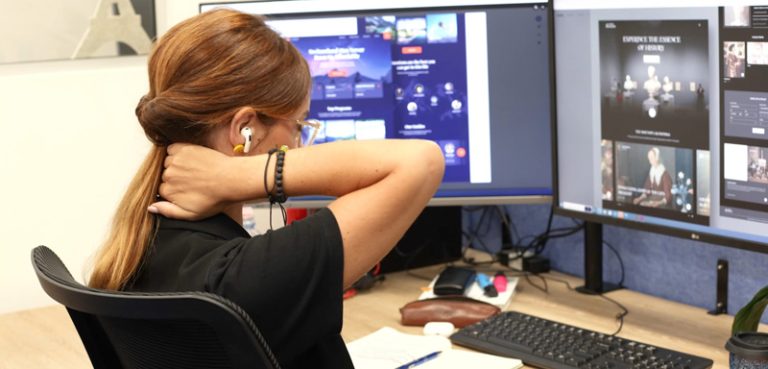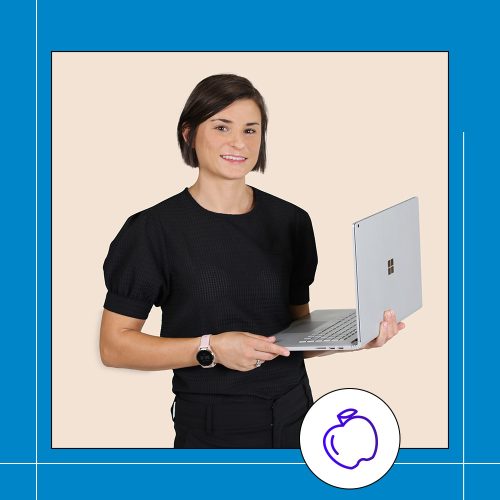An Exercise Physiologist’s perspective: preventing postural injuries requires more than just the right office furniture
Many workers will suffer from some sort of back, neck or joint pain in their life as a result of poor posture while sitting in front of a computer. Fortunately, it doesn’t have to be this way. Via a recent case study, Exercise Physiologist Tina Curtis, tells us how we can make a range of changes that will successfully prevent or alleviate pain, and improve posture, including having the right workstation set-up.
Over time, working in a way that places our bodies in a non-ideal position leads to muscular adaptations where our muscles either become too tight, or weak and lazy. Tight muscles can pull our joints into ineffective positions, while weak muscles lead to imbalances, but both contribute to joint stiffness, loss of mobility, instability and pain.
My career as an exercise physiologist has been primarily focused on musculoskeletal rehabilitation caused by muscle overuse and postural related injuries. I assist clients to identify imbalances, find the root cause, and improve muscle strength or muscle length to overcome the adaptation that is causing them pain. This is usually done with exercise and behavior changes where we identify the areas of their life that contribute to the poor posture and find ways to rectify this.
One of the most common causes of postural related injury and muscular adaptation is postural fatigue. Office workers sit for extended periods of time. If their workstation isn’t set up to fit their body or they aren’t practicing healthy workplace wellbeing habits (you read more about healthy workplace wellbeing habits here) it is easy to have a compromised posture that causes injury and pain.

How this works in practice
I recently conducted a physical assessment on a lady suffering numbness and tingling in her hands and fingers as well as chronic neck pain that radiated down her arm. This assessment revealed weakness in her glutes and core muscles which are responsible for stabilising the lower back and pelvis, leading to an increased lumber lordosis (a curve in the lower spine). As a result, she had developed an increased curve in her upper back to compensate. This occurred because the human body will always adapt to maintain a balanced head position: think of balancing a bowling ball on top of a broomstick – the curves of the spine adapt to keep the ball (your skull) balanced. This compensatory mechanism results in tight muscles at the front of the hip and weak muscles at the back along with tight muscles at the front of the chest and weak muscles in the upper back.
We started our rehabilitation by stretching the tight muscles and loosening up tight joints, then incorporated exercises to strengthen those muscles that had become weakened. This gave the client some immediate actions to work on – and pain relief – while we explored what habits or positions were causing these physical symptoms.
When discussed sleeping position, we discovered that she was sleeping with a very high pillow which further increased the curve in her upper back. Once we removed the extra pillow, the tingle in her fingers resolved quite quickly. We also evaluated her car seat set up to ensure she wasn’t sitting too close to the steering wheel which could contribute to tightness in the front of the hips.
The major point of postural importance though, was her workstation. We discussed the importance of having a comfortable task chair – one that can be adjusted to both the correct height and the correct angle at the hip via seat tilt and a good backrest. We also discovered her mouse and keyboard were too far away and her monitor was too low, forcing her to reach forward causing a poor shoulder position. With a few simple tweaks to her chair settings, the addition of monitor arms and repositioning her mouse and keyboard, we were able to elicit some major improvements in her comfort level at work. This also enabled her to tolerate longer periods at her desk and be more productive.
In summary, the three key areas where you can improve your postural alignment are:
- Sleep: ensure you aren’t using too many, or the wrong, pillows
- Car: ensure your seat is adjusted in such a way that it doesn’t overstrain any muscle groups
- Workstation: ensuring you have the right furniture, with settings that suit your body (like height adjustment, seat tilt and adjustable back rests), plus a good desk set up that doesn’t require you to reach forward or hold your neck in an unnatural way.

Choosing the right furniture
Furniture plays an important role in supporting and encouraging postural endurance and health. Supportive seating and desks, together with healthy workplace habits, are essential to workplace wellbeing and preventing unnecessary muscle and join adaptations and pain.
I am happy to see the shift in focus for workplaces where employee health is valued and there is greater awareness about correct workstation posture. BFX offers a range of ergonomic chairs and desks with a variety of settings that allow workstations to be set up to meet individual physical needs, such as:
- Ergonomic chairs multiple settings like the Riva Ergo Chair or Core Ergo Mesh Chair
- Height adjustable office desks
- Sit-stand desks
- Footrests
The BFX team have a wealth of experience in designing ergonomically-friendly workspaces – contact a BFX Sales and Project Consultant to discuss your needs.











